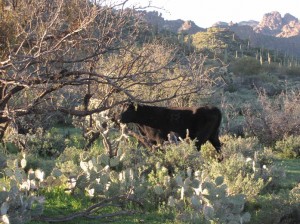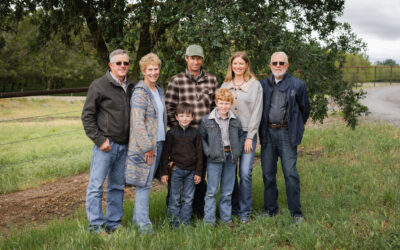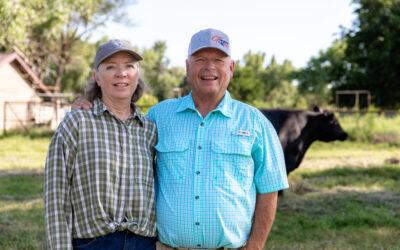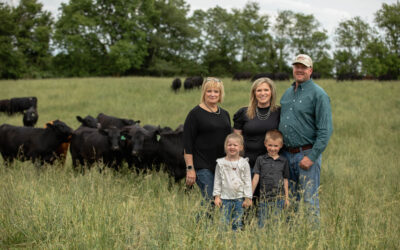
Adding Angus by scientific method

ANYWAY, as Chuck would say to get back on track, the NASA work included a lot of focus on solar energy, too, and political winds suggested a move to earth-based applications. So he and wife Judy came out to The Valley of the Sun, and he helped launch Arizona State University’s solar energy program, even setting up a lab that certifies most of the solar cells in the world.
ANYWAY, he was still a farm boy from West Virginia at heart and looking for a small ranch in the 1970s…a friend in the Farm Credit System alerted him that a historic 10-acre tract was going to be foreclosed on just a few miles southeast of Phoenix. Turns out it was the Quarter-Circle U, where the first men crazy enough to try ranching many years before claimed an unlimited number of desert acres for their 5,000 cattle. By 1974, it lay up against a 22-section state lease rated for 207 cows. Wow. More than he wanted perhaps, but he saw potential for research, and by the end of that decade, he had converted all power to solar. Not long after he turned away from exploring our Solar System, he began to speak of his own solar system.

When the United Nations hosted seminars on solar energy around the world, Chuck presented and transfixed audiences with his documented practical applications. Even his cows were solar branded then.
ANYWAY, cows were kind of along for the ride until he had all the solar and water issues lined up, and bought a few more acres, including a tract up north to allow his base to have six months of rest each summer, and room for 400 cows. No rest for Chuck, however. He was retiring from ASU, but chomping at the bit to dig into cattle ranching with a new emphasis on cattle quality. He thought back to the wild, rodeo-stock cows he’d had to keep on the place the first year just to show his first herd what to eat, and the huge risk of bull mortality coming into a canyon better suited to rattlesnakes than beef cattle.

Using artificial insemination (AI) to breed half of his herd cut that risk, and replacement heifers from top Angus AI sires would grow up knowing their desert resources. Chuck joined the Certified Angus Beef brand’s email discussion list called Black-Ink and added much to discussions of AI and herd improvement strategies. He knew a lot about a lot of things, but adapted the attitude of an eager student in this field.
ANYWAY, he sent a benchmark set of steers to a Texas feedlot in 2006 and found the Beefmaster and Brangus crosses made about 50% Choice, but no premium Choice. Last year, after five years of culling and breeding up and including the first stacked generations of high-quality Angus genetics, a load went 12% Prime and about 80% Certified Angus Beef brand. Wow. He’s not done yet, only halfway through a 10-year genetic upgrade that is now adding an emphasis on feed conversion. This year, a load of steers are being fed at Cattleman’s Choice Feedyard near Gage, Okla. As of today, most of Chuck’s heifers are AI-sired and include some ¾ Angus. How far can he go? Only as far as profit allows.

Eric Grant, of the American Angus Association came with me on this visit, and as I made some comment about the predictability of straightbred Angus from registered bulls, Chuck acknowledged that. But he added, “Just because you can predict the outcome, doesn’t mean it is the desired outcome, or that it maximizes your profit. This country is so rough. I am in the middle of this experiment to see if the higher percentages or straight Angus can do well here.
“If I use primarily AI to bring these super genetics in, and they are raised by my cows on this pasture, and they get all the enzymes in their system that will let them eat what is here—cactus included—if they are raised on this as a baby calf, and learn what they can eat, what they need to eat, then they should be well adapted as replacements. If they fail, it should come back to genetic reasons.”
ANYWAY, it’s not rocket science, just sound thinking. Look for the full story on the Backus Quarter-Circle U experiment in a future Angus Journal or Angus Beef Bulletin.
–Steve
You may also like
Legacy in the Golden Land
On a quiet stretch of Northern California rangeland, a different story unfolds. The Borror family’s legacy modestly speaks through the cattle they raise, the ground they steward. The generations who’ve made a life here demonstrate commitment to doing things right, even when no one is watching.
Helping Hands, Helping Herds
“When I die, I want to come back as one of your cows,” murmurs a friend to Steve Zybach. Full to the brim from an alfalfa ration every day, bountiful fields of lovegrass stretched out across the Texas Panhandle—and owners who leave no ounce of cattle care up for question. The Zybachs’ motivation for this level of dedication to their Angus cattle is simply love.
An Ambassador for All
Joanie, with daughter Lindsey and her husband, Adam Hall, raise registered Angus cattle with two primary goals: producing high-quality seedstock that perform well in a wide variety of environments and ensuring end-user satisfaction. Those goals tie everything together, from promoting Angus to other producers to sharing their story with CAB partners and beef consumers.




